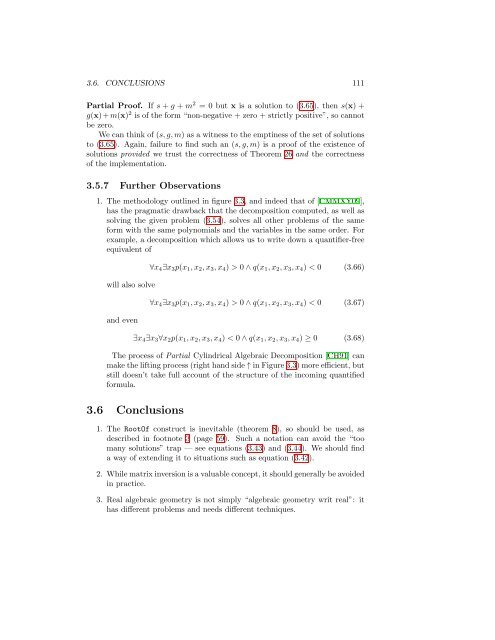Contents - Student subdomain for University of Bath
Contents - Student subdomain for University of Bath
Contents - Student subdomain for University of Bath
You also want an ePaper? Increase the reach of your titles
YUMPU automatically turns print PDFs into web optimized ePapers that Google loves.
3.6. CONCLUSIONS 111<br />
Partial Pro<strong>of</strong>. If s + g + m 2 = 0 but x is a solution to (3.65), then s(x) +<br />
g(x) + m(x) 2 is <strong>of</strong> the <strong>for</strong>m “non-negative + zero + strictly positive”, so cannot<br />
be zero.<br />
We can think <strong>of</strong> (s, g, m) as a witness to the emptiness <strong>of</strong> the set <strong>of</strong> solutions<br />
to (3.65). Again, failure to find such an (s, g, m) is a pro<strong>of</strong> <strong>of</strong> the existence <strong>of</strong><br />
solutions provided we trust the correctness <strong>of</strong> Theorem 26 and the correctness<br />
<strong>of</strong> the implementation.<br />
3.5.7 Further Observations<br />
1. The methodology outlined in figure 3.3, and indeed that <strong>of</strong> [CMMXY09],<br />
has the pragmatic drawback that the decomposition computed, as well as<br />
solving the given problem (3.54), solves all other problems <strong>of</strong> the same<br />
<strong>for</strong>m with the same polynomials and the variables in the same order. For<br />
example, a decomposition which allows us to write down a quantifier-free<br />
equivalent <strong>of</strong><br />
will also solve<br />
and even<br />
∀x 4 ∃x 3 p(x 1 , x 2 , x 3 , x 4 ) > 0 ∧ q(x 1 , x 2 , x 3 , x 4 ) < 0 (3.66)<br />
∀x 4 ∃x 3 p(x 1 , x 2 , x 3 , x 4 ) > 0 ∧ q(x 1 , x 2 , x 3 , x 4 ) < 0 (3.67)<br />
∃x 4 ∃x 3 ∀x 2 p(x 1 , x 2 , x 3 , x 4 ) < 0 ∧ q(x 1 , x 2 , x 3 , x 4 ) ≥ 0 (3.68)<br />
The process <strong>of</strong> Partial Cylindrical Algebraic Decomposition [CH91] can<br />
make the lifting process (right hand side ↑ in Figure 3.3) more efficient, but<br />
still doesn’t take full account <strong>of</strong> the structure <strong>of</strong> the incoming quantified<br />
<strong>for</strong>mula.<br />
3.6 Conclusions<br />
1. The RootOf construct is inevitable (theorem 8), so should be used, as<br />
described in footnote 3 (page 59). Such a notation can avoid the “too<br />
many solutions” trap — see equations (3.43) and (3.44). We should find<br />
a way <strong>of</strong> extending it to situations such as equation (3.42).<br />
2. While matrix inversion is a valuable concept, it should generally be avoided<br />
in practice.<br />
3. Real algebraic geometry is not simply “algebraic geometry writ real”: it<br />
has different problems and needs different techniques.












![[Luyben] Process Mod.. - Student subdomain for University of Bath](https://img.yumpu.com/26471077/1/171x260/luyben-process-mod-student-subdomain-for-university-of-bath.jpg?quality=85)



